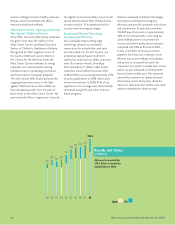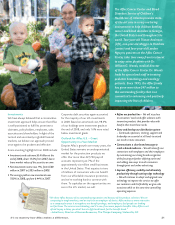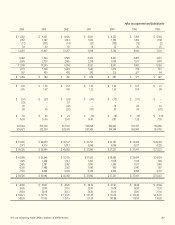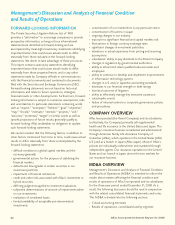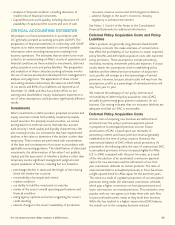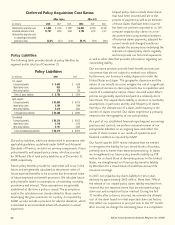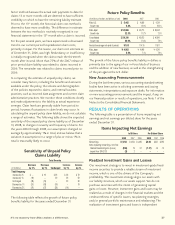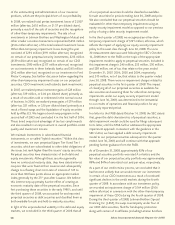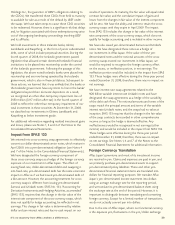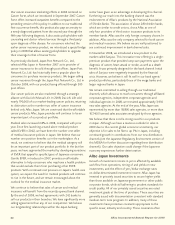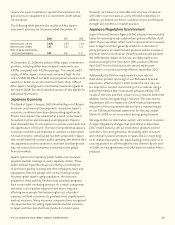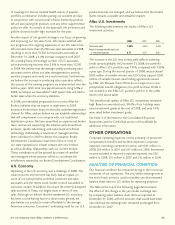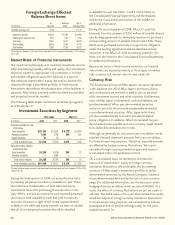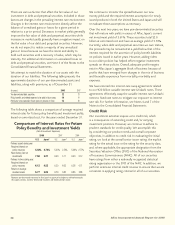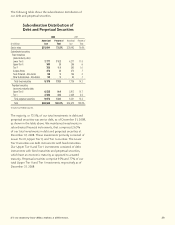Aflac 2008 Annual Report Download - page 33
Download and view the complete annual report
Please find page 33 of the 2008 Aflac annual report below. You can navigate through the pages in the report by either clicking on the pages listed below, or by using the keyword search tool below to find specific information within the annual report.
29
It’s no mystery how Aflac makes a difference.
Holdings Inc., the guarantor of LBSF’s obligations relating to
the CDOs). We transferred these CDOs from held to maturity
to available for sale as a result of the default by LBSF under
the swaps. We have taken steps to cause these CDO securities
to be redeemed. However, there is a significant risk that delays
and/or litigation associated with these redemptions may arise
out of the ongoing bankruptcy proceedings involving LBSF
and its affiliates.
We hold investments in three Icelandic banks, Glitnir,
Landsbanki and Kaupthing, in the form of junior subordinated
debt, some of which include perpetual securities. During the
fourth quarter of 2008, the Icelandic government passed
legislation that allowed certain distressed Icelandic financial
institutions to be placed into receivership under the control
of the Icelandic government. Following the passage of this
legislation, the above noted Icelandic banks were placed into
receivership and are now being operated by the Icelandic
government, which is also in financial distress. Subsequent to
these actions, we learned that it was unlikely that the banks or
the Icelandic government have any intent to honor the banks’
obligations beyond their domestic depositors. As a result,
we recognized an other-than-temporary impairment loss of
$180 million ($117 million after-tax) in the fourth quarter of
2008 to reflect the other-than-temporary impairment of our
total investment in these securities. At December 31, 2008,
we classified our investments in Glitner, Landsbanki and
Kaupthing as below investment grade.
For additional information regarding realized investment gains
and losses, please see Notes 1, 3 and 4 of the Notes to the
Consolidated Financial Statements.
Impact from SFAS 133
We entered into cross-currency swap agreements to effectively
convert our dollar-denominated senior notes, which mature in
April 2009, into a yen-denominated obligation (see Notes 4
and 7 of the Notes to the Consolidated Financial Statements).
We have designated the foreign currency component of
these cross-currency swaps as a hedge of the foreign currency
exposure of our investment in Aflac Japan. The effect of
issuing fixed-rate, dollar-denominated debt and swapping it
into fixed-rate, yen-denominated debt has the same economic
impact on Aflac as if we had issued yen-denominated debt of
a like amount. However, the accounting treatment for cross-
currency swaps is different from issuing yen-denominated
Samurai and Uridashi notes. SFAS No. 133, “Accounting for
Derivative Instruments and Hedging Activities, as amended”
(SFAS 133), requires that the change in the fair value of the
interest rate component of the cross-currency swaps, which
does not qualify for hedge accounting, be reflected in net
earnings. This change in fair value is determined by relative
dollar and yen interest rates and has no cash impact on our
results of operations. At maturity, the fair value will equal initial
contract fair value, and the cumulative impact of gains and
losses from the changes in fair value of the interest component
will be zero. We have the ability and intent to retain the cross-
currency swaps until they expire in April 2009. The impact
from SFAS 133 includes the change in fair value of the interest
rate component of the cross-currency swaps, which does not
qualify for hedge accounting, and is included in other income.
We have also issued yen-denominated Samurai and Uridashi
notes. We have designated these notes as a hedge of
our investment in Aflac Japan. If the value of these yen-
denominated notes and the notional amounts of the cross-
currency swaps exceed our investment in Aflac Japan, we
would be required to recognize the foreign currency effect
on the excess, or ineffective portion, in net earnings. The
ineffective portion would be included in the impact from SFAS
133. These hedges were effective during the three-year period
ended December 31, 2008; therefore, there was no impact on
net earnings.
We have interest-rate swap agreements related to the
¥20 billion variable interest rate Uridashi notes and have
designated the swap agreements as a hedge of the variability
of the debt cash flows. The notional amounts and terms of the
swaps match the principal amount and terms of the variable
interest rate Uridashi notes, and the swaps had no value at
inception. SFAS 133 requires that the change in the fair value
of the swap contracts be recorded in other comprehensive
income so long as the hedge is deemed effective. Any
ineffectiveness would be recognized in net earnings (other
income) and would be included in the impact from SFAS 133.
These hedges were effective during the three-year period
ended December 31, 2008; therefore, there was no impact
on net earnings. See Notes 1, 4 and 7 of the Notes to the
Consolidated Financial Statements for additional information.
Foreign Currency Translation
Aflac Japan’s premiums and most of its investment income
are received in yen. Claims and expenses are paid in yen, and
we primarily purchase yen-denominated assets to support
yen-denominated policy liabilities. These and other yen-
denominated financial statement items are translated into
dollars for financial reporting purposes. We translate Aflac
Japan’s yen-denominated income statement into dollars
using an average exchange rate for the reporting period,
and we translate its yen-denominated balance sheet using
the exchange rate at the end of the period. However, it is
important to distinguish between translating and converting
foreign currency. Except for a limited number of transactions,
we do not actually convert yen into dollars.
Due to the size of Aflac Japan, where our functional currency
is the Japanese yen, fluctuations in the yen/dollar exchange



